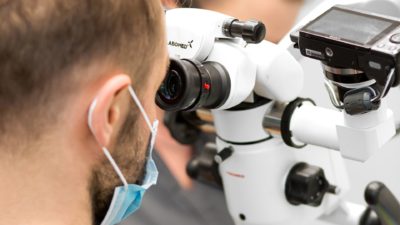Our specialists:

Lek. dent. Przemysław Papiór
SPECIALIST IN DENTAL SURGERY
Endodontic microsurgery is a branch of dentistry whose main goal is to treat complications resulting from pulp removal surgery. Moreover, in the case of anatomical anomalies in the structure of the tooth canal system, its solutions are often the only way to combat the ailments. Precise surgery performed under magnification allows the tooth to remain in the mouth for many years – instead of removing it, we always recommend fighting for the tooth until the very end.
We perform endodontic microsurgery in the following cases:
- Periapical changes – most often these are inflammation of the tissues surrounding the tooth root. The reasons for their development include the action of bacteria, chemical and mechanical factors; which may also be associated with the course of some systemic infectious diseases,
- Occurrence of anatomical anomalies in the structure of the tooth canal system – an atypical morphology of the canal system may make it difficult and sometimes impossible to carry out an effective endodontic treatment,
- Tool fracture during root canal treatment – a situation that may happen during the preparation of blocked or strongly curved dental canals. Most often, the remains of infected pulp tissues remain in the root canal along with the tool – they are responsible for the recurrence of infection and pain, despite the treatment,
- Pushing the filling material past the tip of the tooth – one of the possible complications after root canal treatment. The displacement of the filling material can be diagnosed by X-ray,
- Root canal perforation (e.g. root puncture) – the resulting connection between the tooth cavity and the periodontium. This problem may arise when trying to clean a channel with a complicated, strongly curved structure,
- Cysts – can reduce bone strength, and in extreme situations lead to bone fracture. In most cases, they arise as a result of chronic inflammation of the periapical tissues of the tooth.
Endodontic microsurgery includes the following procedures:
- Tooth apex resection – resection is performed when the patient is struggling with inflammation of the periapical tissues, which is most often manifested by severe pain, often including swelling of the cheek. In order to alleviate the symptoms, removal of the tip of the tooth root and any lesions is performed
- Tooth hemisection – a procedure involving the separation and removal of a part (usually half) of the crown and root of the tooth. This prevents the tooth from being fully extracted and only the part that is completely healthy is left.
- Radectomy – removes one of the tooth roots without disturbing the crown. The procedure is undertaken in the case of multi-rooted teeth – only when the remaining tooth roots are healthy. Radectomy is recommended in the case of periapical changes, vertical tooth fracture, tool fracture in the canal and more,
- Closing the perforation – with the use of a special preparation or by hemisection.
